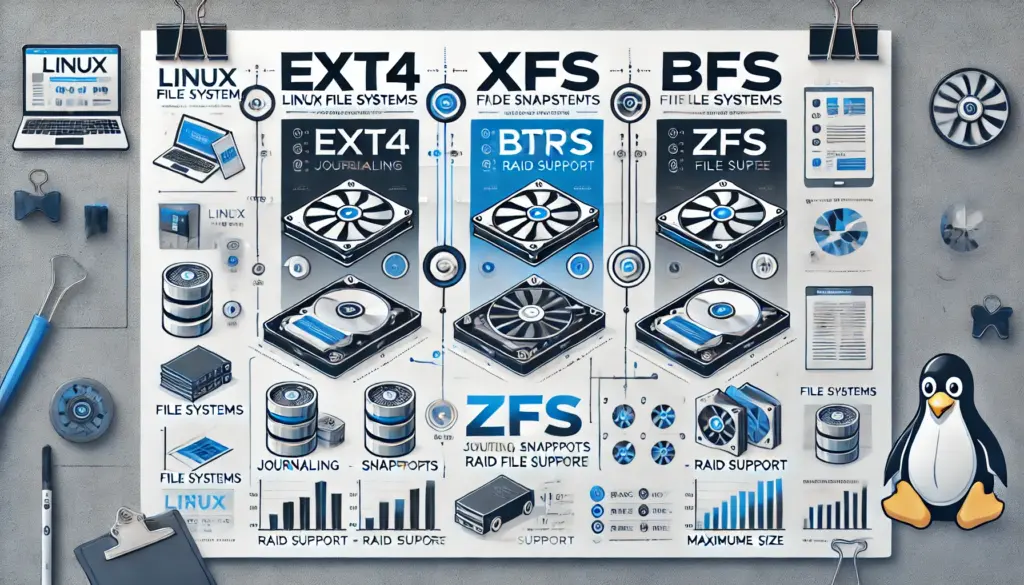Linux File System Explained – Ext4, XFS, Btrfs, and More
🔹 Introduction
Linux File System: A file system in Linux is a crucial component that determines how data is stored, organized, and retrieved. Choosing the right file system directly impacts performance, security, and overall system efficiency.
This comprehensive guide covers:
- The role of a file system in Linux.
- An in-depth look at different Linux file systems (Ext4, XFS, Btrfs, and ZFS).
- Key features, advantages, and best use cases.
- How to manage and troubleshoot file systems effectively.
- Best practices for selecting the right file system for specific workloads.
By the end of this article, you’ll be able to make informed decisions about which file system suits your Linux environment. Let’s dive in! 🚀

🖥️ What is a File System in Linux?
A file system is a logical structure that manages how data is stored and retrieved on a storage device. It organizes files into directories, tracks metadata, and ensures efficient data access.
Each file system has specific features that affect:
- Performance: Read/write speeds, latency, and CPU overhead.
- Data Integrity: Mechanisms like journaling and snapshots to prevent corruption.
- Scalability: Maximum file size and partition support.
- Security: Access control and encryption.
🔹 Checking Your File System
To view the file system type of a mounted disk, run:
lsblk -fTo list all supported file systems:
cat /proc/filesystems🎨 Image Placeholder: [Insert an image showing lsblk -f command output]
🔄 Common Linux File Systems Explained
Linux supports a variety of file systems. Here’s an in-depth look at the most widely used ones:
📝 1. Ext4 (Fourth Extended File System)
Best for: General-purpose Linux systems, servers, and desktops.
✅ Features:
- Journaling for enhanced data integrity.
- Supports files up to 16 TiB and partitions up to 1 EiB.
- Backward compatibility with Ext3 and Ext2.
- Delayed allocation for improved write performance.
🚀 Advantages:
- Reliable and widely supported across Linux distros.
- Optimized for SSDs with TRIM support.
- Fast performance with minimal CPU overhead.
🔹 Creating an Ext4 File System:
sudo mkfs.ext4 /dev/sdX1🔹 Checking and Repairing an Ext4 File System:
sudo fsck.ext4 /dev/sdX1🎨 Image Placeholder: [Insert an infographic explaining Ext4 features]
⚡ 2. XFS (eXtents File System)
Best for: High-performance workloads, enterprise storage, and databases.
✅ Features:
- High-speed parallel I/O operations.
- Supports massive files and volumes (up to 8 EiB).
- Metadata journaling for fast recovery.
- Dynamic inode allocation.
🚀 Advantages:
- Excellent for workloads that involve large file transfers.
- Low-latency performance under heavy loads.
- Maintains efficiency in enterprise environments.
🔹 Creating an XFS File System:
sudo mkfs.xfs /dev/sdX1🔹 Repairing an XFS File System:
sudo xfs_repair /dev/sdX1🎨 Image Placeholder: [Insert a diagram showing XFS architecture]
🏗 3. Btrfs (B-Tree File System)
Best for: Advanced storage management, snapshots, and redundancy.
✅ Features:
- Copy-on-Write (CoW) ensures efficient space utilization.
- Supports built-in snapshots, compression, and RAID.
- Online resizing and self-healing for data integrity.
- Checksumming for data validation.
🚀 Advantages:
- Highly flexible and feature-rich.
- Prevents silent data corruption.
- Efficient disk space utilization.
🔹 Creating a Btrfs File System:
sudo mkfs.btrfs /dev/sdX1🔹 Creating a Snapshot:
sudo btrfs subvolume snapshot /mnt/data /mnt/data_backup🎨 Image Placeholder: [Insert an illustration of Btrfs snapshots and CoW]
🌊 4. ZFS (Zettabyte File System)
Best for: Enterprise storage, high data integrity, and large-scale deployments.
✅ Features:
- Built-in RAID-Z for redundancy.
- Advanced data integrity with checksums.
- Automatic error correction.
- Supports compression and deduplication.
🚀 Advantages:
- Prevents silent data corruption.
- Ideal for large-scale storage solutions.
- Self-healing capabilities.
🔹 Installing and Creating a ZFS File System:
sudo apt install zfsutils-linux
sudo zpool create mypool /dev/sdX1🎨 Image Placeholder: [Insert a comparison chart of ZFS vs. Btrfs]
📊 File System Comparison Table
| Feature | Ext4 | XFS | Btrfs | ZFS |
|---|---|---|---|---|
| Journaling | Yes | Yes | Yes | Yes |
| Snapshots | No | No | Yes | Yes |
| RAID Support | No | No | Yes | Yes |
| Compression | No | No | Yes | Yes |
| Max File Size | 16 TiB | 8 EiB | 16 EiB | 16 EiB |
🎨 Image Placeholder: [Insert a visual table comparing all file systems]
🔍 Choosing the Right File System
- Use Ext4 for general-purpose Linux systems.
- Use XFS for high-performance and large file operations.
- Use Btrfs for snapshots, compression, and modern storage management.
- Use ZFS for enterprise-level data integrity and redundancy.
🛠️ Troubleshooting File Systems
Checking File System Health
sudo fsck /dev/sdX1Repairing File System Errors
For Ext4:
sudo fsck.ext4 -y /dev/sdX1For XFS:
sudo xfs_repair /dev/sdX1For Btrfs:
sudo btrfs check /dev/sdX1📌 Summary
- You learned about popular Linux file systems (Ext4, XFS, Btrfs, ZFS).
- You explored their key features and best use cases.
- You discovered how to format, mount, and manage file systems.
- You now have a guide to choosing the best file system for your needs.
📚 Learn More:
💬 Have questions? Drop them in the comments below!


